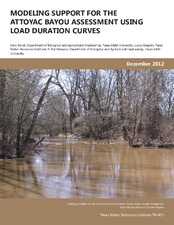| dc.description.abstract | A popular approach currently applied in the development of Watershed Protection Plans (WPP) and Total Maximum Daily Loads (TMDL) is to identify whether point or non-point sources are the primary pollutant contributors in a water body. The development of load duration curves (LDC) is an accepted method of accomplishing this goal (USEPA, 2006a). The LDC approach was developed for assessing nutrient loading in streams (Cleland, 2002) but has been adapted to assess bacteria loads as well. This graphical approach combines daily stream flow with water quality data for the pollutant to be evaluated. It is assumed that point sources are a constant loading that are present during all flow regimes where as non-point source loadings are present in streams during high flows due to runoff events (Cleland, 2003). This approach relies solely on the field data available, thus the LDC determines load reductions for the flow conditions at which measurements were taken (Li and Guo, 2003). A needed load reduction is calculated based on the percent exceedance above the maximum allowable load line. In Texas, the water quality standard to assess a water body’s ability to meet primary contact recreation standards is a geometric mean concentration of 126 CFU/100 mL of E. coli and a single sample criterion of 399 CFU/100 mL. This bacterium is used as an indicator of potential fecal derived pathogen presence in the monitored water body (TCEQ, 2010). | en |


